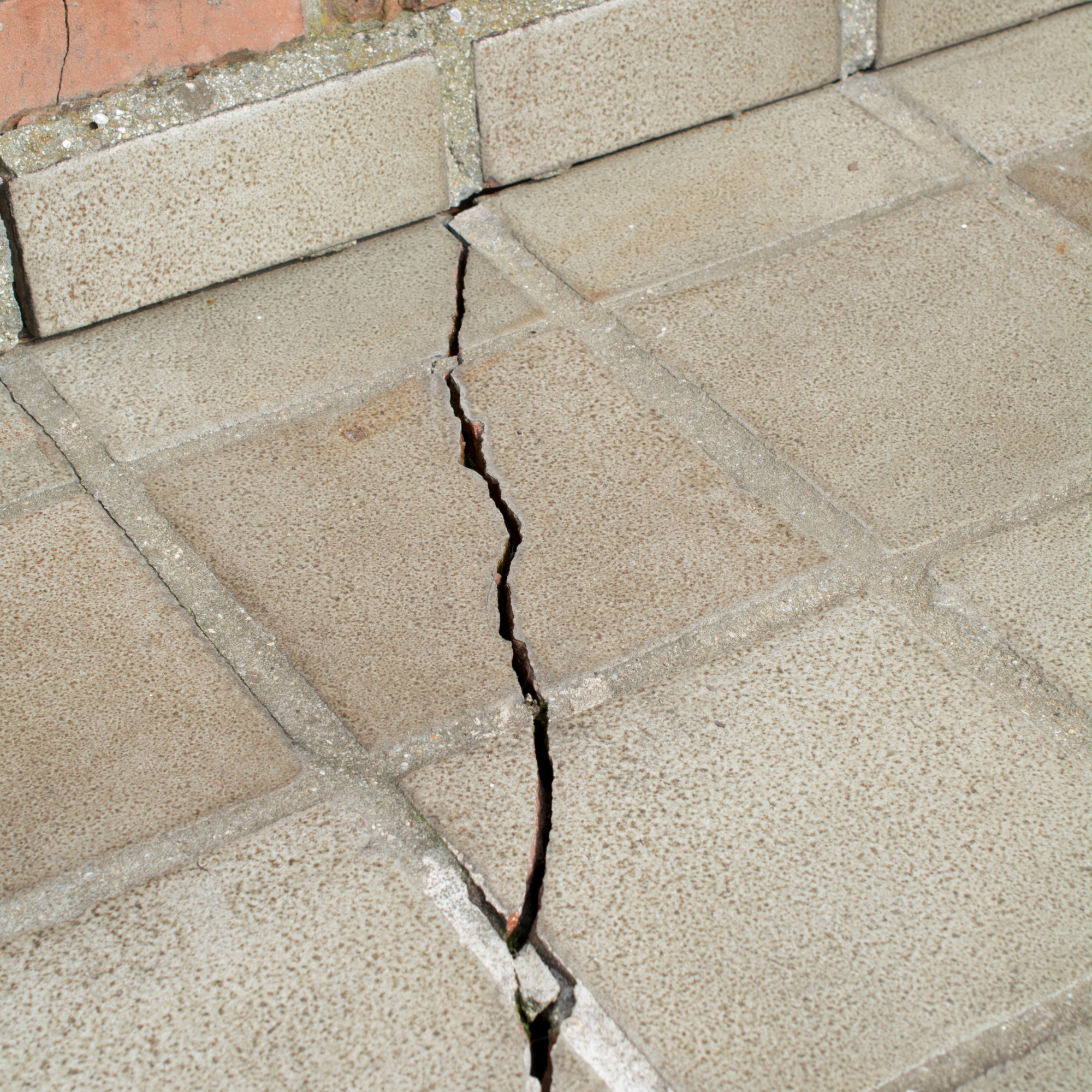Can you repair patio cracks yourself? Experts reveal the two factors that make this an easy DIY job or an irreparable issue
It's possible to repair patio cracks in a few simple steps...

General wear and tear, temperature changes (granted, we see a lot of those in the UK!), and poor installation are all factors that can lead to cracks in your patio, but can you repair patio cracks yourself?
As tempting as it might be, patio cracks are not something you can turn a blind eye to, unfortunately. Not only can they pose a safety risk, but they can also create structural issues and, in some cases, even decrease the value of your house.
Before you start to panic, the good news is that in many cases, you can repair patio cracks yourself in a few simple steps, leaving you free to get on with the fun stuff –those exciting patio ideas.
How to repair patio cracks
So, if you've been staring at a crack in your patio wondering whether you can fix it yourself (and importantly, avoid making a patio mistake, it really depends on two things, says Tom Hall, a building expert from Kingfisher Direct.
'The difficulty of fixing a patio crack yourself will depend on the extent of the damage and your level of DIY experience.
'If you don't know what has caused your patio to crack, it may be best to consult a professional before attempting any repairs yourself. Wider cracks are best repaired by a mason or a repair specialist,' advises Tom.

Tom Hall is a category executive at Kingfisher Direct. Tom's expertise spans a wide range of DIY-related topics, and he enjoys sharing his knowledge with those seeking guidance on home improvement and maintenance projects.
It's also important to note that the professionals recommend replacing the slab completely if you're faced with a big crack.
'If you have large cracks in your patio, I advise fully replacing it with a new slab, rather than attempting to fix it, says Mark Irving, building expert from Build & Plumb.
'Replacing the slab will not only improve the appearance of your patio, but it will ensure that the patio is durable and can bear heavy weight without safety concerns,' Mark says.

With over 20 years of experience in the building sector, Mark led Build & Plumb’s expansion into online marketplaces. Mark has a wealth of knowledge surrounding building and renovating that he enjoys sharing with others who are looking to complete their own building projects.
What you'll need
- Wire brush, like this Forge Steel Set of 2 from Screwfix
- Concrete repair filler for small hairline cracks, try this No Nonsense Concrete Repair from Screwfix
- Concrete repair mortar for bigger cracks, such as this No Nonsense Concrete Repair Mortar also from Screwfix
- Trowel, like this Spear & Jackson Hand Trowel from Amazon
- Putty knife, such as the Prep Premier Putty Knife from Toolstation
- Sandpaper with different grits like this Assorted Grit Wet & Dry Sandpaper from Amazon
1. Identify the cause of the crack
Before you round up the tools that repair patio cracks, the first thing you should do is find the source of the issue, says Mark. 'Always remember that before fixing a patio crack, it’s important to identify the underlying cause of the crack and fix this problem first. Failure to do so will likely lead to the crack returning,' he warns.
Because there could be a fairly long list of reasons why you're seeing cracks in your patio, this is where you may need to consult a professional, says Lee Tretheway from Sustainable Furniture.
'If the damage is particularly extensive, caused by plant roots or because it's not been laid properly, I recommend getting professional help as this might be a bit more difficult.'


Lee Trethewey is the general manager at Sustainable Furniture. Having worked in the industry for 10+ years, Lee is an expert in all things interior and garden design, as well as well-versed in eco-friendly practices and sustainable sourcing.
2. Clean the crack
The next step is to clear the area of any furniture and clean your patio. Pay particular attention to the crack and the area around it to get rid of weeds, any debris and remove algae that might have built up.
'Remove any loose or damaged concrete from the slab. This can be done with a chisel, and remaining debris can be swept away with a wire brush,' says Tom from Kingfisher Direct.
Once you've done this, you should wash the crack with soapy water, advises Lee. 'You'll need to let it dry completely,' he says.

3. Select the correct filler
Depending on where the crack is and its size, you may need different products.
'If the crack is in the concrete, use a specialised concrete repair mortar or caulk specifically designed for outdoor use. If crackers are in the joints, use polymeric sand (such as this Sika Fast Fix one from Screwfix) or paver joint filler (try this No Nonsense one),' says Simon Wardle, patio expert at Armstrong Cheshire.
'To fix small hairline cracks that are half an inch wide, you will need an acrylic-based filler, caulking gun, putty knife and sandpaper,' advises Mark, Build & Plumb.
'To make the patch less noticeable, use a filler that is a similar shade to your patio,' he adds.
4. Apply the filler
Always use the crack repair filler as instructed by the manufacturer, and it's wise to apply a small test area first.
'Apply the filler to the crack with a trowel or putty knife to fill the crack completely, and you should make sure the product is pushed all the way down into the crack,' advises Mark, Build & Plumb.
5. Smooth the surface
Once the filler has been applied, you'll need to remove any excess product from the patio slab and smooth over the surface with a trowel and putty knife before the product dries.
Make sure to smooth the filler over the crack and remove any over-filled pieces,' says Lee.

6. Allow to dry and sand the surface
You can (almost) relax as you've done all the hard work now and will soon be able to get cracking with your concrete patio ideas.
The final step to repair patio cracks and get your patio area looking as good as new is to let it dry before sanding the surface.
It's important to follow the product instructions for drying time which will vary depending on the type of filler you have used.
Concrete patching compounds may take several hours to set fully, while polymeric sand typically takes 24 hours to cure.
FAQs
Are cracks in patios normal?
Whilst small cracks, known as hairline cracks, in patios are very common, that's not the case for bigger, obvious cracks.
'In the UK, where the weather fluctuates frequently, it can be extremely common for cracks to occur in your patio. As the temperature fluctuates it can cause shrinkage and expansion of the patio slabs and result in hairline cracks,' says Mark Irving from Build & Plumb.
However, large cracks or cracks that continue to widen are not normal and indicate a problem, according to Simon Wardle from Armstrong Cheshire.
'Proper patio installation and regular maintenance will help reduce the number of cracks that appear. In particular, pay attention to high-traffic areas,' Simon advises.
How do I fill my patio gaps to stop weeds?
Before you tackle filling the gaps, you should make sure you've got rid of all traces of weeds, says Mark Irving from Build & Plumb.
'Prior to filling cracks in your patio, it’s crucial that you remove all weeds and fully remove the full root to prevent them from growing back. You may also consider spraying a weed killer before filling the gaps to ensure that the weeds are completely dead.'
There are several ways you can fill the gaps in a patio to prevent weeds from growing through says Tom Hall from Kingfisher Direct.
'Polymeric sand can be poured in the gaps between paving slabs to prevent weeds from growing through. The sand often has a pH that creates an uninhabitable environment for weeds and can withstand many years before the weed inhibiting effects wear off.'
'You can also use a jointing compound to fill the gaps between the patio slabs. The compound is brushed into the gaps between paving, and this will create a barrier to stop weeds from growing through.'
There you have it: six simple steps to repair patio cracks. Now you can enjoy your patio space for the summer. Now, all you need are some patio lights to really kick back in style...
Get the Ideal Home Newsletter
Sign up to our newsletter for style and decor inspiration, house makeovers, project advice and more.
You must confirm your public display name before commenting
Please logout and then login again, you will then be prompted to enter your display name.
-
 Is a shower ledge better than a shower niche? I asked bathroom experts why this storage option reigns supreme
Is a shower ledge better than a shower niche? I asked bathroom experts why this storage option reigns supremeIt's the best way to store your shampoo and conditioner stylishly
By Holly Cockburn
-
 AI is heading into the kitchen – should you be considering upgrading to a smart appliance?
AI is heading into the kitchen – should you be considering upgrading to a smart appliance?They claim to make your life easier, and daily chores more efficient
By Ginevra Benedetti
-
 Garden colour schemes that work with Cuprinol's Natural Stone – 5 beautiful palette pairings
Garden colour schemes that work with Cuprinol's Natural Stone – 5 beautiful palette pairingsThe best colour matches, from sage green to dusky pink
By Sophie King